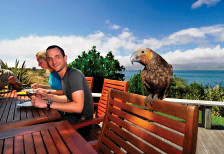
Kapiti Island is omnipresent. Driving over Pukerua Bay hill, it’s in your face. All along the coast, it’s there. From Ōtaki Beach looking South it’s there. Eight km long, two km wide, it’s only five km off Paraparaumu beach.
Two centuries ago, Te Rauparaha used it as his base to wage war on other tribes.
Whalers used Kapiti as a base thereafter, with over 2,000 living on the island to hunt whales for their blubber, which contained oil. Remnants of their occupation still exist. In 1897 Kapiti was declared a bird sanctuary.
Today, Kapiti is mostly owned by the crown, administered by Department of Conservation (DoC). The northern end of Kapiti belongs to descendants of the Ngāti Toa, Te Āti Awa and Ngāti Raukawa confederation. The Barrett family operate Kāpiti Nature Lodge. John Barrett and his sister Amo Clark have lived there on & off since 1970. Today, it’s a thriving tourist destination, world famous among conservationists, birdwatchers and nature lovers.
The island was farmed until 1966, and it was only with the Resource Management Act and the formation of the Department of Conservation that Kapiti was transformed into a conservation icon. With the eradication of rats in 1998, things took off. The island is now home to a number of native birds, mostly re-introduced. These include takahē, kokako, brown teal, stitchbird (hihi), saddleback (tīeke), tomtit (miromiro), fantail (pīwakawaka), morepork (ruru), weka and North Island robin (toutouwai). The brown kiwi and little spotted kiwi were released on the island between 1890 and 1910, and the island is now the stronghold for the latter species. Rat eradication has led to increases in red-fronted parakeets, North Island robins, bellbirds, and saddlebacks: now the island is considered one of New Zealand’s most important sites for bird recovery, as well as a major breeding site for sea birds. In April 2005, the critically endangered short-tailed bat was introduced to the island from a threatened population in the Tararuas, providing them with a separate, safer habitat.
Visiting Kapiti
Department of Conservation trips
Visiting Kapiti is strictly controlled. There are two options, both requiring permits from DoC, both involve a short journey by boat from Paraparaumu Beach. To visit the central (DoC) part of Kapiti costs $75. There is a limit of 100 visitors/day, which is often not filled. The most popular visiting season is September through April. DoC provides toilets and a visitor shelter. There are well-signposted tracks, and the walk to the summit, 521m takes around 3 hours, return trip. You are guaranteed to see an amazing collection of native birds, from the Takahe, which looks like a big chook, to zillions of Tui, Saddleback, Kereru and Weka. While Kiwi abound, the only way you’ll see them is if you stay overnight.
John Barrett’s Kapiti Island Nature Tour
The second option is with John Barrett’s Kapiti Island Nature Tours.
They offer a number of options, from Basic (DoC permit, transport to & from Kapiti) to an overnight stay, with all meals, and night-time kiwi-spotting. John says Kiwi sighting is not guaranteed, but this year they’ve had almost 100% success. You will be inundated with tui, bellbirds, kereru, kaka.
Prices from $75 basic transport only through $165 day tour with guided walks and lunch, to overnight with all meals and guided kiwi spotting from $335.
Kapiti Island Nature Tours (www.kapitiislandnaturetours.co.nz) can accommodate 20 guests overnight and 50 by day They guarantee comfy beds, good food, and a collegial fraternising with the Barrett whanau and other guests, which foreign visitors think is very special. And yes, they even have wi-fi!
What’s changed over the years?
John recalls how many old Ōtaki families would spend time on Kapiti Island. The Cooksleys, Ropatas, Cootes, Watsons and Parata families all had strong associations with the island.
Now, he reckons less that 10% of Otaki’s population has been on the island. That’s a shame. It’s a genuine taonga, and deserves to be understood and appreciated.
The future?
John Barrett says that what’s desperately needed is a decent starting point for visitors. Right now, boats take you from Paraparaumu Beach, but at the entry point there’s no reception centre, no toilets and nowhere for biosecurity inspection of baggage before embarkation. Hardly the way to impress our overseas visitors. What’s needed is a Visitor Centre. His grand vision is of a theaterette for DoC to centralise their Kapiti operations, viewing options with underwater cams and bird cams to show off the enormous diversity of water and avain life that abounds. A foreshore visitor centre would cost $2 million at the least, probably three times that for a great facility for the Kapiti Coast. How to fund such a venture? There is a national tourist development fund that would be sympathetic, a philanthropic investor would be fantastic, and a pro-active KCDC might see it as a signature project. It’s time…
Disclosure: the writer has made three trips to Kapiti Island, and is looking forward to his fourth.


